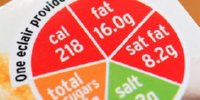We will help to educate you about nutrition

Did you know that to use the claim ‘low fat’, a manufacturer may compensate by adding in lots of sugar so as to make the food taste nicer. Even the term ‘light’ only means that a product must be at least 30% lower than standard products in at least one typical value such as calories or fat (listed on the label on the back of the pack). Even ‘no added sugar’ means that whilst no additional sugar has been added, the food may be full of naturally occurring sugars, which we should also cut down on.
Did you know that ‘brown bread’ doesn't necessarily mean that the bread is much healthier than white bread. Brown bread may be brown purely because it is made from dark flour, such as graham flour or whole-wheat flour. It is wholemeal bread that uses the germ of the wheat and the whole grain which is an excellent source of dietary fibre and B vitamins. Wholemeal bread contains twice that of white & brown bread .
Did you know that ingredients on a packet are listed in order of quantity, with the item in largest quantity listed first. This is essential to know because some products, such as fizzy drinks may seem quite healthy according to the nutritional information as they are low in sugars and fat. It is only when we read the ingredients list that we notice that the drink is filled with artificial sweetener, making it very unhealthy.
Food labels can be very confusing and with food manufacturers constantly releasing new terminology and marketing claims, we will help you navigate all of this information and help provide clear and accurate advice. We can help by:
- Explaining marketing terminology such low fat, light and no added sugar as mentioned above as well as other claims made by manufacturers.
- Examining issues around GM foods, colouring, preservatives, emulsifiers, sweeteners, thickeners as well as other e-numbers.
- Exploring claims made by food supplement manufacturers such as vitamin supplements and protein shakes.
- Food fortification techniques and tips on how to cook the same meal but with lower calories substitute ingredients.
- Important tips on food packaging and the importance of using different packaging techniques.
- Instructions on how to store different foods.
- Techniques on how to protect against chemicals that might transfer into your food from packaging.
- Allergy advice and an examination of the allergy statements made on packaging.
- Advice on issues surrounding organic food and techniques on how to remove any chemicals from foods not produced organically